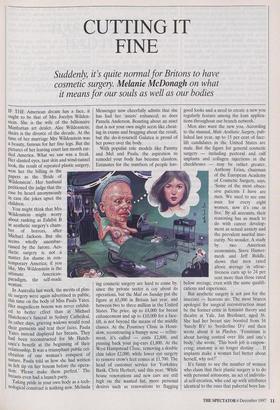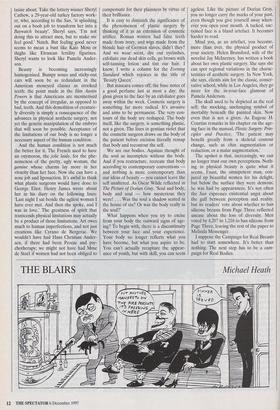CUTTING IT FINE
Suddenly, it's quite normal for Britons to have it means for our souls as well as our bodies
IF THE American dream has a face, it ought to be that of Mrs Jocelyn Wilden- stein. She is the wife of the billionaire Manhattan art dealer, Alec Wildenstein; theirs is the divorce of the decade. At the time of her marriage Mrs Wildenstein was a beauty, famous for her fine legs. But the pictures of her leaving court last month rat- tled America. What we saw was a freak. Her slanted eyes, taut skin and wind-tunnel look, the result of repeated plastic surgery, won her the billing in the papers as the 'Bride of Wildenstein'. Her husband petitioned the judge that the case be heard anonymously in case the jokes upset the children.
You might think that Mrs Wildenstein might worry about ranking as Exhibit B in aesthetic surgery's cham- ber of horrors, after Michael Jackson. But she seems wholly unembar- rassed by the furore. Aes- thetic surgery is not a matter for shame in con- temporary America; if you like, Mrs Wildenstein is the ultimate American- paradigm, the self-made woman.
In Australia last week, the merits of plas- tic surgery were again advertised in public, this time on the body of Miss Paula Yates. Her magnificent bosom was never exhibit- ed to better effect than at Michael Hutchence's funeral in Sydney Cathedral. In other days, grieving widows would rend their garments and tear their faces. Paula Yates instead displayed her breasts. They had been reconstructed for Mr Hutch- ence's benefit at the beginning of their relationship. It was a triumphant public cel- ebration of one woman's conquest of nature. Paula told us how she had written in felt tip on her bosom before the opera- tion: 'Please make them perfect.' The breasts even had a launch party. Taking pride in your own body as a tech- nological construct is nothing new. Melinda Messenger now cheerfully admits that she has had her 'assets' enhanced; so does Pamela Anderson. Boasting about an asset that is not your own might seem like cheat- ing in exams and bragging about the result, but the do-it-yourself Galatea is proud of her power over the body.
With populist role models like Pammy and Mel and Paula, the aspiration to remodel your body has become classless. Estimates for the numbers of people hav- ing cosmetic surgery are hard to come by, since the private sector is coy about its operations, but the Mail on Sunday put the figure at 65,000 in Britain last year, and between two to three million in the United States. The price, up to £4,000 for breast enhancement and up to £10,000 for a face- lift, is not beyond the means of the middle classes. At the Pountney Clinic in Houn- slow, recontouring a bumpy nose — refine- ment, it's called — costs £2,800, and pinning back your jug-ears £1,800. At the West Hampstead Clinic, removing a double chin takes £2,000, while lower eye surgery to remove crow's feet comes at £1,700. The head of customer service for Yorkshire Bank, Chris Herbert, said this year, 'While house renovations and new cars are still high on the wanted list, more personal desires such as renovations to flagging good looks and a need to create a new you regularly feature among the loan applica- tions throughout our branch network.'
But aesthetic surgery is not just for the insecure — heavens no. The most brazen apologist for surgical reconstruction must be the former critic in feminist theory and theatre at Yale, Jan Breslauer, aged 36. She had her breast size boosted from 34 `barely B's' to 'borderline D's' and then wrote about it in Playboy. 'Feminism is about having control over life and one's body,' she wrote. 'This boob job is empow- ering; anatomy is no longer destiny . . . If implants make a woman feel better about herself, why not?'
It's funny to see the number of women who claim that their plastic surgery is to do with personal autonomy, an act of individu- al self-creation, who end up with attributes identical to the ones that pubertal boys fan- tasise about. Take the lottery winner Sheryl Cathew, a 29-year-old turkey factory work- er, who, according to the Sun, 'is splashing out on a boob job to transform her into a Baywatch beauty'. Sheryl says, 'I'm not doing this to attract men, but to make me feel good.' Natch. But feeling good never seems to mean a bust like Kate Moss or thighs like Etruscan fertility figurines. Sheryl wants to look like Pamela Ander- son.
Beauty is becoming increasingly homogenised. Bumpy noses and sticky-out ears will soon be as redundant in the American moneyed classes as crooked teeth: the point made in the film Austin Powers is that Americans are mesmerised by the concept of irregular, as opposed to bad, teeth. And this demolition of creature- ly diversity is simply a consequence of the advances in physical aesthetic surgery, not yet the genetic manipulation of the embryo that will soon be possible. Acceptance of the limitations of our body is no longer a necessary aspect of the human condition.
And the human condition is not much the better for it. The French used to have an oxymoron, the jolie laide, for the phe- nomenon of the pretty, ugly woman, the gamine whose charms lay more in her vivacity than her face. Now she can have a nose job and liposuction. It's awful to think what plastic surgeons would have done to George Eliot. Henry James wrote about her in his diary on the following lines: `Last night I sat beside the ugliest woman I have ever met. And then she spoke, and I was in love.' The greatness of spirit that transcends physical limitations may actually be a product of those limitations. Art owes much to human imperfections, and not just creations like Cyrano de Bergerac. We wouldn't have had Hans Christian Ander- sen, if there had been Prozac and psy- chotherapy; we might not have had Mme de Stael if women had not been obliged to compensate for their plainness by virtue of their brilliance.
It is easy to diminish the significance of the phenomenon of plastic surgery by thinking of it as an extension of cosmetic artifice. Roman women had false teeth made from ivory, and wigs made from the blonde hair of German slaves, didn't they? And we wear scent, dye our eyelashes, exfoliate our dead skin cells, go brown with self-tanning lotion and tint our hair. I know; I write a column for the Evening Standard which rejoices in the title of `Beauty Queen'.
But mascara comes off; the base notes of a good perfume last at most a day; the gloss given to the face by an exfoliator goes away within the week. Cosmetic surgery is something far more radical. It's invasive and aims to be permanent. The very con- tours of the body are reshaped. The body itself, like the surgery, is something plastic, not a given. The lines in gentian violet that the cosmetic surgeon draws on the body of the patient before excision literally remap that body and recontour the self.
We are our bodies. Aquinas thought of the soul as incomplete without the body. And if you restructure, recreate that body according to contemporary conventions and nothing is more contemporary than our ideas of beauty — you cannot leave the self unaltered. As Oscar Wilde reflected in The Picture of Dorian Gray, 'Soul and body, body and soul — how mysterious they were! . . . Was the soul a shadow seated in the house of sin? Or was the body really in the soul?'
What happens when you try to excise from your body the outward signs of age- ing? To begin with, there is a discontinuity between your face and your experience. Your body no longer reflects what you have become, but what you aspire to be. You can't actually recapture the appear- ance of youth, but with skill, you can seem ageless. Like the picture of Dorian Gray, you no longer carry the marks of your past, even though you give yourself away when- ever you open your mouth. A tucked, suc- tioned face is a bland artefact. It becomes harder to read.
Mind you, as an artefact, you become, more than ever, the physical product of your society. Helen Bransford, wife of the novelist Jay McInerney, has written a book about her own plastic surgery. She says she can spot regional variations in the charac- teristics of aesthetic surgery. In New York, she says, clients aim for the classic, conser- vative school, while in Los Angeles, they go more for the in-your-face glamour of Pamela Anderson.
The skull used to be depicted as the real self, the mocking, unchanging symbol of mortality beneath the painted skin. Now even that is not a given. As Eugene H. Courtiss remarks in his chapter on the age- ing face in the manual, Plastic Surgery: Prin- ciples and Practice, 'The patient may benefit greatly from a skeletal contour change, such as chin augmentation or reduction, or a malar augmentation.'
The upshot is that, increasingly, we can no longer trust our own perceptions. Noth- ing in physical beauty is quite what it seems. Faust, the omnipotent man, con- jured up beautiful women for his delight, but below the surface they were demons; he was had by appearances. It's not often the Sun expresses existential angst about the gulf between perception and reality, but its readers' vote about whether to ban silicone breasts from Page Three reflected unease about the loss of diversity. Men voted by 4,207 to 1,216 to ban silicone from Page Three, leaving the rest of the paper to Melinda Messenger.
I suppose the Campaign for Real Breasts had to start somewhere. It's better than nothing. The next step has to be a cam- paign for Real Bodies.



















































































 Previous page
Previous page